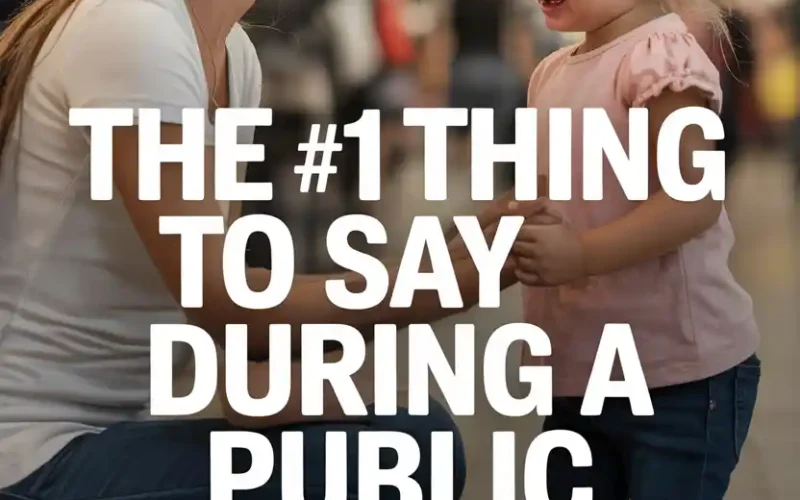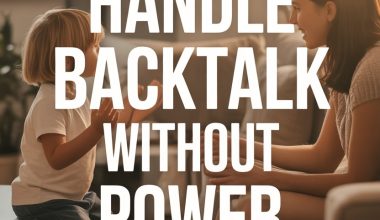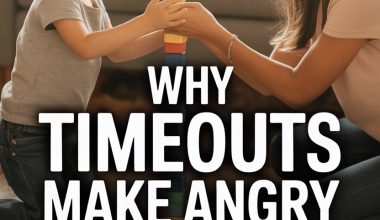Picture this: You’re in the queue at the supermarket, half your trolley is full of broccoli you’ll try to convince your family to eat, and your child has decided now is the perfect moment to stage a full-scale emotional protest.
Sobbing, wailing, perhaps a dramatic limp to the linoleum—your little cherub transforms into a pint-sized performance artist.
Every parent has been there. If you haven’t, either you have no children or your toddler is actually a very well-trained border collie in disguise.
The world freezes as you choose your next move.
Ignore it? Bribe with biscuits? Apologise to strangers? Whisper, “You’re embarrassing me!” and hope to be swallowed by the floor?
There’s one phrase—one magical sentence—that can turn this high-stress, high-drama moment into an opportunity for genuine connection (and maybe even a quicker exit).
Let’s cut to the chase.
Say: “I’m Here With You.”
This is the #1 thing to say. Not because it’s a mystical incantation, but because it’s an anchor for your child (and frankly, for yourself).
“I’m here with you.”
Simplicity itself. No grand speeches, no need to channel your inner child psychologist, no public displays of mum-guilt.
Just a few words that communicate support, safety, and presence.
It’s a phrase that tells your child, “You’re not in this alone, even if your feelings are bigger than you can handle right now.”
And isn’t that what we all want—someone steady when we’re falling apart?
Why This Works: Science and Sanity
The experts are in your corner. According to child psychologist Dr. Tina Payne Bryson, co-author of The Whole-Brain Child, attunement and presence during meltdowns help children develop emotional regulation.
When you offer your calm, grounded self, you’re lending your nervous system to theirs.
Neurologically speaking, kids’ brains are still building the parts necessary for self-control and emotional management. When you say, “I’m here with you,” you’re helping them feel safe enough to move through the storm.
Not to mention, it signals to passersby (and your own frazzled brain) that you’re handling things—no need to call security over an inconsolable three-year-old.
It’s Not About Fixing, It’s About Being
Every fibre of your being may itch to “fix” the meltdown. Maybe you want to explain why the Peppa Pig cereal isn’t coming home with you, or remind your child about the chocolate waiting at Nanna’s.
Here’s the twist: Fixing rarely helps in the white-hot moment of distress. Connection does.
“I’m here with you” means you’re not rushing your child to get over it, nor are you scolding for making a scene. You’re offering a safe harbour.
This approach is backed by research from the Center on the Developing Child at Harvard, which suggests that responsive relationships are the foundation for healthy emotional development.
The “Public” Part: Managing Embarrassment and Bystanders
Nothing like the glare of an audience to make parenting feel like extreme sport.
You might worry about being judged. (Spoiler: Some people will judge you no matter what you say or do. They probably judge puppies, too.)
Here’s a trick: Focus on your child, not on the crowd.
When you kneel down, get to eye level, and say, “I’m here with you,” you’re sending a silent message to everyone else—“I’ve got this. Move along, folks.”
You might be surprised; some strangers will catch your eye and offer a nod of solidarity. Those are your people. The rest can scroll their phones and wish they’d brought headphones.
When Your Child Can’t Hear You Over the Wailing
Meltdowns have a decibel range matched only by jet engines and certain pop concerts. If your “I’m here with you” gets lost in the din, it still matters.
Your child may not absorb your words through the noise, but your tone, body language, and presence speak volumes.
Stay close. Keep your voice gentle. Resist the urge to escalate. (You’ve never won an argument with a four-year-old in full meltdown mode, and you never will.)
Often, soothing repetition—like a mantra—helps both child and parent keep a grip on their sanity.
What Not to Say (Tempting as It May Be)
“I’ll give you something to cry about.”
“Big kids don’t act like this.”
“You’re embarrassing me.”
“Stop it right now.”
These classics may have fallen out of the parenting handbooks, but they sometimes bubble up when you’re at your wit’s end. They usually backfire, making your child feel alone, shamed, or misunderstood.
No need for perfection. If one of these slips out, forgive yourself and try again. You’re only human (despite suspicions that you might be a caffeine-powered robot).
Tweaking Your Delivery for Different Ages
Tiny humans and not-so-tiny humans need different flavours of the same support.
For toddlers:
Hunker down, get close, keep your words brief. “I’m here with you. It’s okay to be sad.”
For preschoolers:
Acknowledge the feeling, offer your presence, and add a touch of validation. “I’m here with you. I know you really wanted that toy.”
For older kids (yes, meltdowns don’t have an age limit):
Respect privacy if they want it, but let them know you’re nearby. “I can see you’re upset. I’m here if you need me.”
For teenagers (public meltdowns look different—think icy silence and eye rolls):
Give space, but keep the invitation open. “I’m around if you want to talk.”
Handling Your Own Big Feelings
Let’s be honest—sometimes you want to have your own meltdown right alongside your child. The stress, the scrutiny, the sense that you’re failing at this whole parenting gig.
Pause. Breathe. Give yourself the same compassion you offer your child.
If you need to step back for a moment (safely, of course), do it. Text a friend. Send your partner an SOS meme. Every parent needs backup.
What to Do When “I’m Here With You” Doesn’t Seem to Work
Some days, your best efforts fall flat. The tears keep rolling, the screams echo off the tile, your child seems immune to all comfort.
That’s normal. Sometimes feelings just need to run their course.
Stick with it. The phrase “I’m here with you” isn’t magic; it’s practice.
Over time, your child learns you’re dependable, even if the supermarket staff starts recognising you on sight.
Sometimes a gentle touch, a hand to hold, or just sitting together until the moment passes does more than any lecture or distraction ever could.
And if you have to abandon your trolley and make a hasty retreat? That’s parenting, too.
When You Have an Audience Who Just Won’t Quit
Occasionally, someone feels compelled to comment. The all-knowing stranger leans in with unsolicited advice, a pointed glance, or the dreaded, “In my day…”
Feel free to respond with a firm but polite, “We’re okay, thank you.” Or, if you’re feeling cheeky, “We’re just practicing our drama skills for the next West End audition.”
Public parenting doesn’t require a script for the peanut gallery. Your job is your child, not the critics.
Building Your Child’s Emotional Toolbox
Each time you respond with calm presence, you’re helping your child build their own internal toolkit.
Over time, they’ll learn that big feelings can be managed, that support is available, and that even spectacular supermarket meltdowns are survivable.
Yours might even start to say, “I’m here with you” to a sibling or friend someday.
Who knows? Perhaps they’ll pay it forward with their own children—though don’t be surprised if they claim they never melted down themselves.
When You Need a Re-Do (Yes, You’re Allowed)
Some days, nothing goes right. You responded with sarcasm, you threatened to confiscate every toy in the house, your voice reached a pitch only dogs could hear.
Apologise. Kids are resilient and so are you. “I’m sorry I lost my cool earlier. I’m here with you now.” That’s the good stuff. Repair is as important as response.
Parenting isn’t about perfection; it’s about connection.
Next Time You’re Caught in the Aisle
The next time your little darling melts into a puddle of despair over the wrong brand of yoghurt, take a breath, kneel down, and try those magic words: “I’m here with you.”
You might not get applause from fellow shoppers, but you’ll know you’ve done the one thing that matters most.
And hey, there’s always online shopping for next time.





